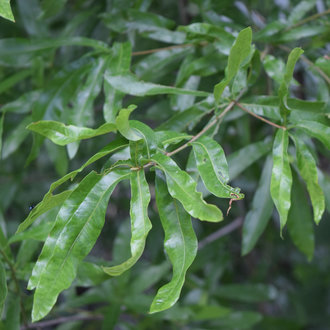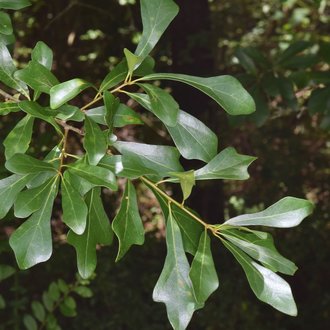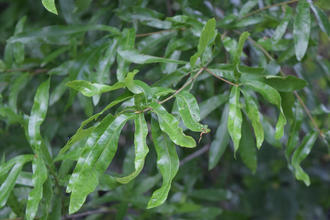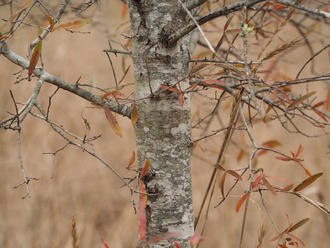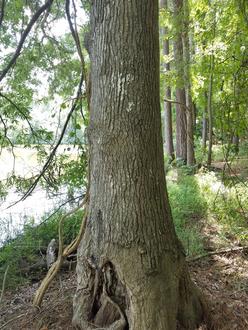Willow Oak (Quercus phellos L.)
↑Summary
An oak native to poorly-drained bottomlands in the southeastern U.S., named for the willow-like shape of its leaves.
↑Range - Expand
| Legend | Color |
| Native | |
| Expanded or Not Present | |
| Native or Not Present | |
| Native or Expanded |
This map is based on our research. We have checked its accuracy to Level 3 ecoregions. Although this plant occurs somewhere in each of these regions, it may only occur in a small part of some or all of them.
↑Similar Plants
↑Habitat
Found on poorly-drained sites, mostly in bottomlands, on ground transitional between swamps and upland mesic forests. Where it overlaps in range, it typically occurs together with laurel oak (Quercus laurifolia) in the south or pin oak (Quercus palustris) in the north, and on slightly lower, wetter sites than swamp chestnut oak (Quercus michauxii) and cherrybark oak (Quercus pagoda), although Laurel oak prefers slightly wetter conditions than this species.
Tolerates flooding in winter and early spring, but not in summer. Usually found where the water table is between 1 foot and 10 feet below the ground surface, ideally 2 to 6 feet.
Most of its habitat is on drier ridges and high flats in the floodplains of large rivers, or in infrequently-flooded floodplains of smaller streams. Found rarely in uplands, usually where there is locally-poor drainage.
Prefers slightly acidic, wet to moist alluvial soils that are deep and uncompacted, ideally, silty-to-loamy in texture.
Needs relatively high light conditions for regeneration, but often forms a stable climax community, as it is among the most shade-tolerant species able to grow in its preferred moisture conditions.
Generally found in habitats that rarely or never burn.
↑Life Cycle
Trees begin producing acorns around 20 years of age. Unlike most oaks, acorn production is relatively consistent from year to year. The acorns are very small for an oak, and are primarily dispersed by blue jays, which prefer the acorns of this species to most oaks.
Acorns germinate under the soil surface, in spring, following a period of cold-dormancy. Acorns are able to survive weeks of submersion in water, which somewhat reduces germination and survival, but not enough to affect this species' ability to survive in habitats that flood over the dormant season.
Seedling growth is moderate in ideal conditions, growing up to 4.5 feet (1.4 m) in two years. Growth can be stunted on poorly-aerated sites. Seedlings can persist for as long as 30 years under a closed forest canopy of the density that typically occurs in the wet bottomlands where this species is found.
Seedlings are not drought-tolerant and require consistent moisture for optimal growth, but do best when the soil is not completely saturated.
Once established, mature trees may survive up to 3 years of continual flooding, but will eventually die, following death of their root system due to lack of aeration.
Smaller trees will resprout vigorously from stumps if top-killed.
Trees are thin-barked and highly vulnerable to fire; even low-intensity fires will kill seedlings, and more severe fires will top-kill large trees. However, the leaves have a high moisture content which tends to inhibit entry of fire into stands of willow oak.
↑Uses
Used as a landscaping plant and sometimes a street tree; favored for its rapid growth and ease of transplanting. Able to survive considerably farther north than its native range. Particularly useful for planting along the margins of reservoirs with fluctuating water levels, due to its ability to tolerate temporary flooding.
Also used for its wood, and considered a preferred timber species in much of its range. The wood is similar to that of other oaks of the red oak group, with good physical properties but less durable than that of white oaks. Commonly used in cabinetry and furniture making.
Also favored in wildlife management, as its acorns support numerous birds and other animals.
Can be used to rehabilitate disturbed sites in bottomlands; grows well on material excavated for canal construction
↑Related Plants
Closely related to and occurring together with numerous other oaks of the red oak group.
Thought to be closest-related to running oak (Quercus pumila), followed by laurel oak (Quercus laurifolia).
Hybrids have been recorded with at least nine different oaks.
↑Links & External Resources
• Willow Oak | The Wood Database (About This Site)
• Willow Oak | Fire Effects Information System (FEIS) (About This Site)
• Quercus phellos (Willow Oak) | Illinois Wildflowers (About This Site)
• Quercus phellos (Willow Oak) | USDA PLANTS Database (About This Site)
• Quercus phellos | Go Botany (About This Site)
• Quercus phellos (Willow Oak) | Missouri Botanical Garden Plant Finder (About This Site)
• Willow Oak | Virginia Tech Dendrology Factsheets (About This Site)
• Willow Oak | Silvics of North America (About This Site)
• Quercus phellos | Biota of North America Project (BONAP) (About This Site)
• Quercus phellos | NatureServe Explorer (About This Site)
• Quercus phellos | Flora of North America (About This Site)
• Willow Oak | Maryland Biodiversity Project (About This Site)
• Quercus phellos Linnaeus (Willow Oak) | Digital Atlas of the Virginia Flora (About This Site)



